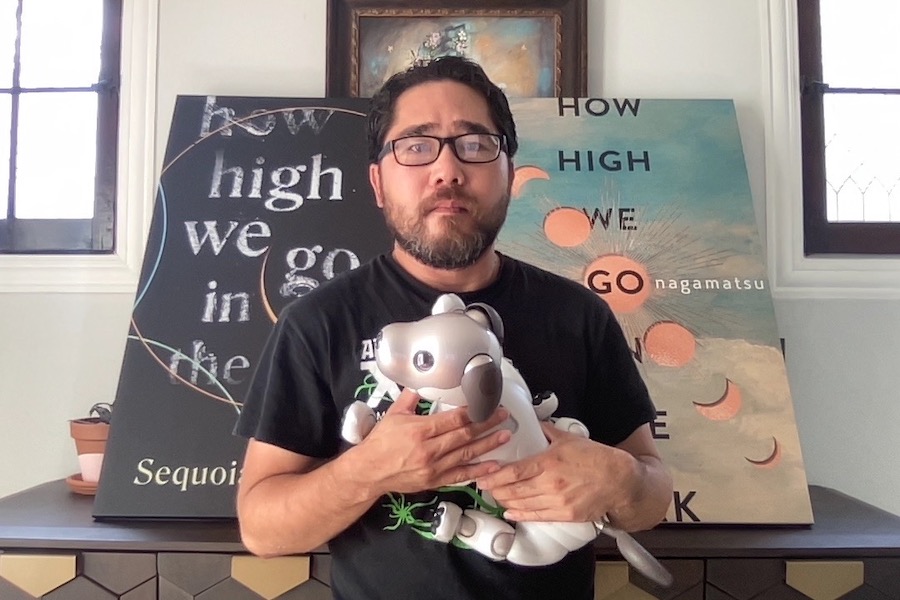For the last decade, Minnesota-based writer Sequoia Nagamatsu has been thinking about the future—what is inevitable, what may come, and the possibilities of his wildest dreams.
Now Nagamatsu’s debut novel is about to be published, and it’s a rare phenomenon in the 21st century: a Big Book. Not a brief flicker in the cultural cosmos, but a comet bearing down on the literary world—like the kind you might find in some of those books about the future.
How High We Go In the Dark (out January 18 through William Morrow) has drawn comparisons to modern classics like David Mitchell’s Cloud Atlas, George Saunders’s Lincoln in the Bardo, and Emily St. John Mandel’s Station 11. It’s been praised by literary tastemakers like Roxane Gay and the cantankerous savant Alan Moore, who said it “orchestrates its multitude of memorable voices into beautiful and lucid science fiction.”
There’s just one catch with this book about the distant future that Nagamatsu has been writing for half of his adult life. “It does have a plague element,” he says with a chuckle.
Nagamatsu has had plenty of time to get used to the fact that he wrote a forward-looking novel about a catastrophic viral event just as a real-life global pandemic began. He and his agent had conversations about whether or not they should wait to pitch the novel. “But I had been working on it for so long,” he says. “When we started talking to editors, producers, booksellers, a good amount of people understood.”
Because How High We Go In the Dark isn’t just a plague story; it’s a story that begins with a plague.
In 2030, a grieving father visits a research site at the Batagaika Crater in the Arctic Circle where his recently deceased daughter had been working, leading to the dispersal of a long-frozen virus. The novel traces the catastrophic effects of this plague across generations, connecting the stories of a mother trying to save her son at a theme park built for terminally ill children, a scientifically altered pig that gains the power of speech, and a family journey to space.
“There are seeds and narrative threads that go back billions of years to the origins of the Earth… and thousands of years into the future as well,” Nagamatsu says. “There’s also another cosmic thread that runs throughout, and Easter-egg hints in every chapter, and it pulls the entire novel together by the end.”
The book began as a collection of short stories, the oldest of which Nagamatsu began writing at an internet cafe in Japan in late 2008 and early 2009, before he even considered himself a writer. He’s since gotten his MFA, published an acclaimed short story anthology, Where We Go When All We Are Is Gone, and moved to Minnesota, where he teaches at St. Olaf College. He’s under contract for another book.
But for now, that’s a little too far in the future. At the moment Nagamatsu is just eager—“and relieved,” he adds—for people to read this fantastical story of tremendous scope that is, for him, an intimate tale about the ways in which people grieve. These themes, inspired by losses he’s suffered in his own family, have been thrust to the forefront of the public consciousness by the real-life pandemic.
“We’ve been forced to reevaluate what dying means,” Nagamatsu says. “Death has been kind of a taboo subject in the West. We haven’t really been allowed to grieve or have healthy discussions about the body. I mean, capitalism—the first thing on your mind is money. ‘I gotta organize a funeral, pay for hospital bills, take care of whatever logistical things.’ That doesn’t leave you a lot of room to think about someone’s life.”
Online memorials and the still-accessible social media profiles of the dead are a kind of mourning enabled by technologies. It’s these ideas and concepts Nagamatsu wants to explore, far out into the great unknown.
“It’s gonna be a difficult read for some people for sure, I’m not gonna lie about that,” he says. “But there’s a lot of hope.”
So How High We Go In the Dark is about much more than a plague. Although, when you’re talking to a guy who was thinking about all the far-flung possibilities of a pandemic for several years before he saw one actually occur, what about the last two years did he not see coming?
“People’s behavior,” Nagamatsu says, “especially in America, maybe the UK as well. I think if I had written a story and there was this life-altering plague and I told editors that a large segment of the population wasn’t interested in curing it, they would be like, ‘What the fuck, that doesn’t seem realistic at all.’”







